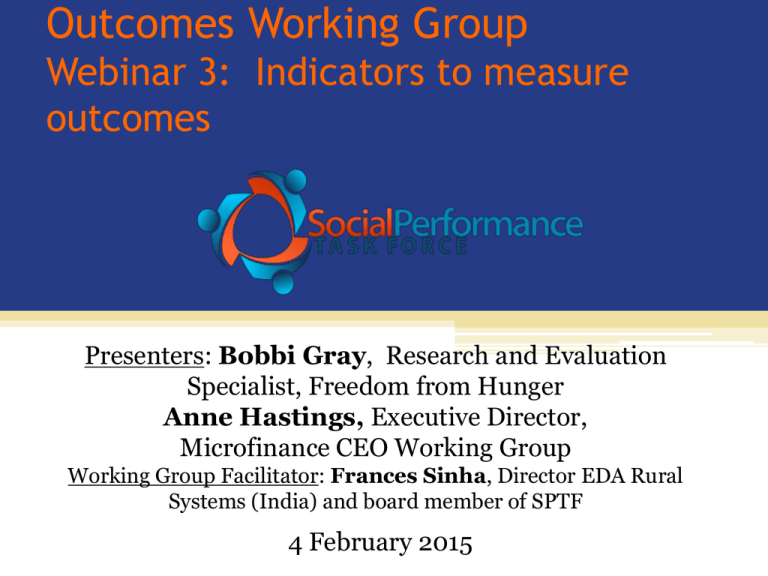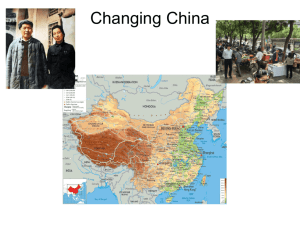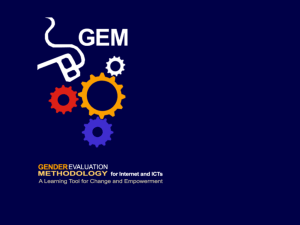Preventive health care
advertisement

Outcomes Working Group Webinar 3: Indicators to measure outcomes Presenters: Bobbi Gray, Research and Evaluation Specialist, Freedom from Hunger Anne Hastings, Executive Director, Microfinance CEO Working Group Working Group Facilitator: Frances Sinha, Director EDA Rural Systems (India) and board member of SPTF 4 February 2015 Agenda • Introduction (5mins) • Bobbi (FFH): criteria to develop indicators related to health outcomes; application by 4 MFIs, lessons (15-20mins) • Anne (MCWG): developing a system for standardized measurement, review of outcomes studies (69), selecting themes and indicators for microfinance (15-20mins) DISCUSSION Recap • Previous webinar : Theory of Change framework: ▫ Defining short-term/intermediary and long term changes ▫ Assumptions – links from different services/uses to changes ▫ Attrition factor - not all participants will stay the course • Next logical step to identify relevant practical indicators to measure changes - and the steps that lead to changes: • • • • Criteria for identifying practical, relevant indicators Selection relevant to microfinance What is the experience? Can we build consensus on a ‘standard menu’ ? Indicators The basics • • • • • Specific, relevant - define objectives Practical to measure - credible Unambiguous - clear Can compare, benchmark Limited number – necessarily selective Trade-offs in e.g. what is practical to measure (household income or expenditure) and/or unambiguous (women’s role in decision making) Health Outcome Performance Indicators Project Theories of Change: Improved Health Access to and use of financial services: loans; insurance; savings; payments; health loans and savings Access to and use of health services: education, provision of curative and preventive health services Integrated health and financial services: direct provision and linkages between sectors Increased income Consumption smoothing Coping with shocks Seek prompt medical treatment Seek preventive health care Improved health knowledge and seeking prompt medical treatment and preventive health care Cross-sectoral efficiency gains in provision of financial and health services to poor populations Improved health outcomes Seek prompt medical treatment Seek preventive health care 6 Choosing Health Indicators Usability/ Reliability Measurabl e by an FSP Can be reported in client survey Can change in shortterm Addresses relevant measures for FSPs Cannot rely on specific interventio ns to change outcomes Be applicable for both genders Can be benchmarke d to other data (MDGs, regional data, etc.) Reliability Likelihood of inclusion Usability Criteria Feasibility PPI/PAT Yes Yes Maybe Yes Yes Yes Yes Yes High Food security index Yes Yes Yes Yes Yes Yes Yes Maybe High Use of preventive health services Yes Yes Yes Maybe Maybe Yes Maybe Maybe High/ Moderate Access to safe drinking water (MDG 7) Yes Yes Maybe Yes Maybe Yes Yes Maybe High/ Moderate 7 Current Pilot Partners Financial Service Provider Country No of Clients being served by FSP No. of clients participating in health indicators survey ADRA Peru 17,039 95 CARD Philippines 1,828,052 472 ESAF India 322,590 1,000 Equitas India 1,344,361 250 8 Survey Adaptations Poverty measurement – Use of country-specific PPIs Food security and nutrition –added a focus on food items in India to reflect stronger focus on nutrition Preventive health care – focuses on institutional births in India; annual exams and Pap tests in Peru; various annual exams in the Philippines and use of health insurance (PhilHealth) Curative Health Care: Questions same in all three countries – forgoing medical treatment and purchase of medicines due to cost Water and Sanitation– Focuses on defecating in the open and treating water to make it safer to drink in India; Open defecation, water sources, and water treatment in Peru; Water sources and treatment of water in the Philippines Attitudes: Only measured in Peru and Philippines, accesses levels of confidence related to ability to cover future medical costs and seek adequate medical care 9 Lessons Learned Standardization of indicators may be difficult. Proceed with caution in the interpretation of results. Baseline values will be important to establish. Baseline values with high levels of performance may not be useful to track. The value of statistical analysis – ex. correlations between indicators of interest with poverty – can help refine our “theory of change” as well as determine which indicators may be the most useful to help us understand changes in client outcomes. Who to track and for how long? This is a very important question to answer as it influences which indicators will be the most useful. This process requires patience. 10 Accion BRAC & BRAC International CARE Access Africa FINCA International Freedom from Hunger Grameen Foundation Opportunity International Pro Mujer VisionFund International Women’s World Banking Collaborating on Outcomes The Goal of Our Work on Outcomes To develop, test and disseminate a common core measurement and monitoring system designed to: Be cost-effectively embedded within an MFI’s operations Use industry-standard indicators and metrics (PPI) Provide affiliated MFIs with actionable client outcome data that can be tracked over time Allow MFIs the flexibility to measure those changes in client outcomes they wish to affect using the same indicators for the same outcomes Enhance the Working Group’s ability to demonstrate and improve the benefits of Responsible Microfinance for the clients being served Contribute to the sector’s understanding of client outcomes The Proposed Method 1. Select the indicators to test 2. Target countries and the MFIs 3. Pilot the indicators Social performance (SP) leads will work with their partners to collect, analyze and report on the data SP leads and MFI partners would convene to discuss experiences, identify lessons learned and develop recommendations for future use SP leads will develop and publish a series of briefs by outcome area with theory of change and recommended indicators Package and disseminate the final indicators along with supporting documentation Lessons from the Working Group’s Review of Outcomes • Phase 1: Catalogued 69 different outcomes research from all 8 members and their affiliates ▫ Wide variation in product studied, methodology, indicators, quality of research, etc. ▫ Difficult to draw definitive conclusions when comparing outcomes across programmes Different methods RESEARCH COMPONENTS QUANT. SURVEY 44 QUAL. SURVEY 15 CONTROL GROUP 30 LIT REVIEW 27 KII 16 BANK RECORDS 16 FGD 15 OTHER DATA 1 ENDLINE 25 MIDLINE 4 BASELINE 24 0 10 20 30 40 50 Different themes INDICATORS ASSETS EDUCATION INCOME WELL-BEING HEALTH BUSINESS (NON-FARMING) EXPERIENCE WITH MF PROGRAMS FIN LITERACY POVERTY OUTREACH POVERTY STATUS EMPOWERMENT SAVINGS FOOD SECURITY FARMING (BUSINESS) PERSONAL VIEW OF EC'C STANDING SHOCKS / COPING MECHS NUTRITION SOCIAL CAPITAL CHILD GROWTH 6 31 28 11 30 29 16 7 4 14 17 23 25 15 10 14 10 10 3 0 5 10 15 20 25 30 35 A Closer Look at Education Studies 1. There was a big range of indicators being used across and within the networks. 2. There was little consistency across institutions. 3. Most studies only looked at one dimension of education. Phase 2: Identifying Potential Indicators for 7 Types of Client Outcomes 1. 2. 3. 4. 5. 6. 7. Food security Coping strategies/shocks Economic poverty (income or financial status) Health Assets, housing and business Social capital and empowerment Child and youth education Phase 2: Summary of Indicators Food security % of households that are food insecure (levels measured vary by tool) Coping strategies/shocks % of households that had to [make a specific adjustment or level of change] to cope with the effects of [household or community shock] Economic poverty (income or financial status) % of households living above/below a given poverty line Health % of households with [level of access] to health care [services/supplies] Phase 2: Summary of Indicators Assets, housing and business % of households that were able to [purchase assets/improve their homes] in the past year Social capital and empowerment % of [women] expressing confidence in making decisions regarding [specific category] % of clients who perceive [specify benefit or value] in group participation Child and youth education % of children in the household who are regularly attending school % of households with increased ability to pay for school fees Discussion 1. Any questions/clarifications? 2. What is your experience in indicator selection? 3. Can we aim at standardisation - synchronisation? 4. Our working group: contributing to guidelines for selection (and a menu) of indicators to measure client outcomes? Thank you • For follow up, please contact: info@sptf.info, francessinha@edarural.com • Please note: presentations and recordings from all Outcomes Working Group Meetings are being posted to the SPTF website, working groups page: http://sptf.info/sp-task-force/workinggroups








